Creating surplus situations in different zones around the field is what football is all about. To do so, you need to work on your team’s possession, include overloads, practice individual play with the ball and out of it, secure the pass and employ constant movement – and then you’ll have something, to begin with for working on exploiting surpluses.
World’s best teams like Pep Guardiola’s Manchester City, Hans-Dieter Flick’s Bayern Munich and Thomas Tuchel’s Paris Saint-Germain all base their tactics on the exploitation of overloads and isolation making them the key parts of their attacking gameplans. This coaching tactical analysis will bring you three drills that could help you isolate players with more ease and secure numerical superiority situations by working on them in beforehand on the training ground.
Overview
The thing about isolation is that it mostly benefits the fast transformational teams, the ones that are quite good with the ball at their feet and to the ones that have creative and technically gifted individuals who are good in direct face to face duels against their guards. The key principle of isolation is to overload on the opposite side, which demands a high-concentration of players in the restricted area of the pitch, so their teammate(s) could have the wider space on the opposite side to exploit if the ball is directed towards them.
Working on this type of play requires working in tight areas with a number of players, with ball security under-pressure being one of the main factors for success. All of the shown exercises are the mixture of multiple coaching segments that are necessarily closely related to creating isolation, such as position-holding, off the ball movement, defensive communication, and plenty more.
Rondo-transformation game
The first drill we are going to talk about is the one that is very good for the opening phases of practice, because it has a lot of basic movements, but can also be very useful in the closing stages of training if you are in the lower-intensity period. The setup for it is very simple, a classic rondo box set about 20-25 meters from goal, with two wide cones on both sides of the playing square. Eight players included in the game are divided into two teams, with four attackers (red markers) keeping the ball inside the box against the two defenders (blue markers), whose two players are positioned outside the cones.
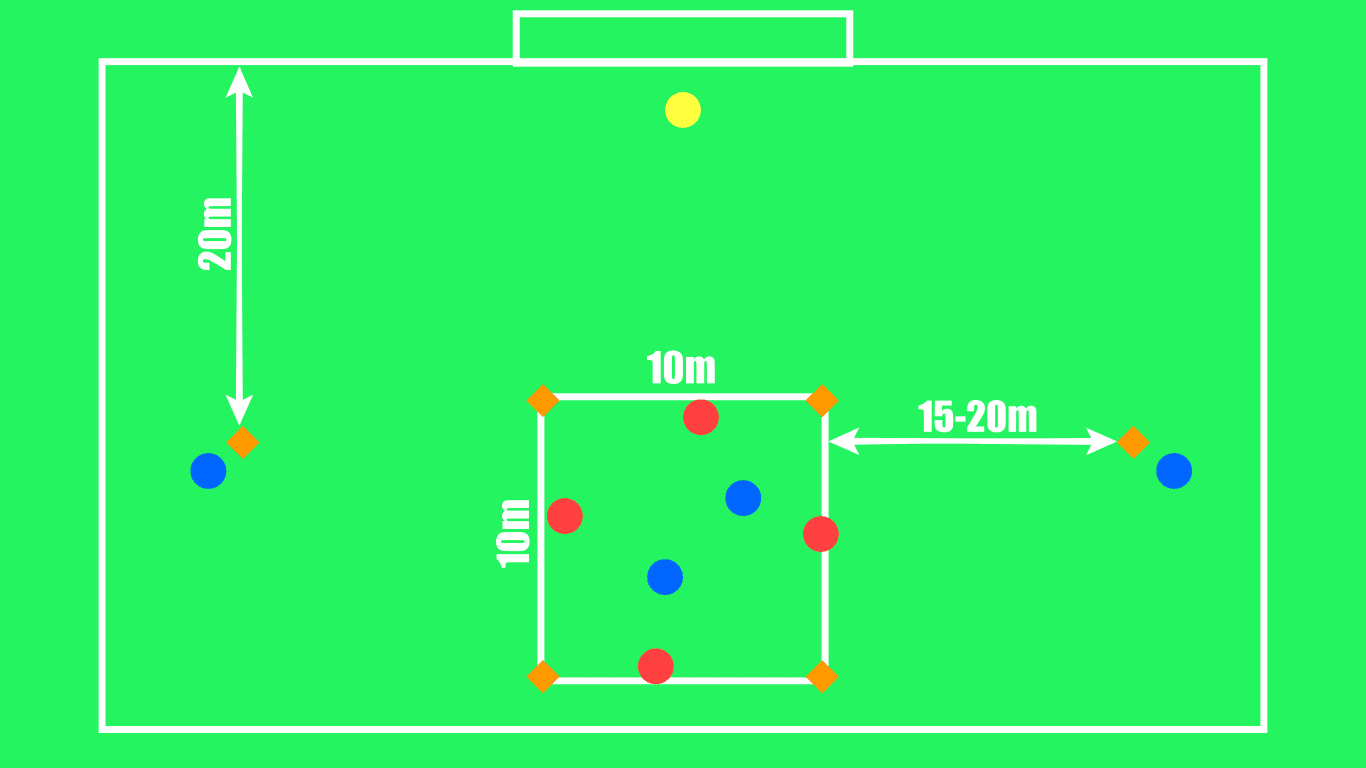
The initial task for the possession team is to get to ten passes inside the box, after which one of them breaks into 1v1 finishing situation against the goalkeeper. The blues need to move constantly to try and win the ball and prevent the opponents from getting into goal scoring situations.
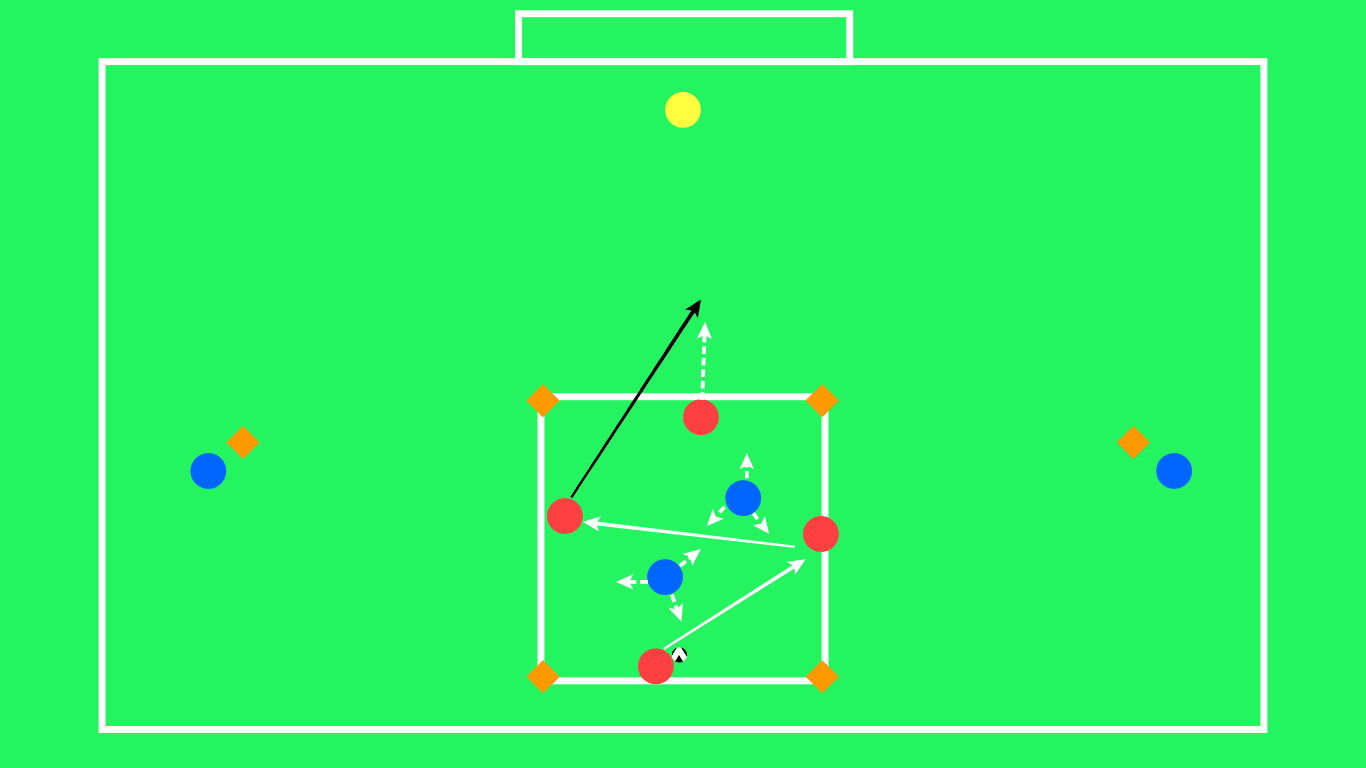
Focus on the isolation play happens if the attacking team loses the ball, and it is important to point out that this drill can also be coached for plenty of other game segments. When the red team make a passing error, the blue team’s goal is to pass the ball to one of the wide players – whichever is the best option regarding the situation in which they’ve won the possession.
After they manage to find their teammate and break out of the box, two defenders go straight towards the goal, waiting for the cross coming from the wide areas. The wide blue players are isolated in these positions without opposition pressure and their goal is to dribble the ball towards the horizontal sideline and to supply their attackers who perform these motions that are shown in the picture below.
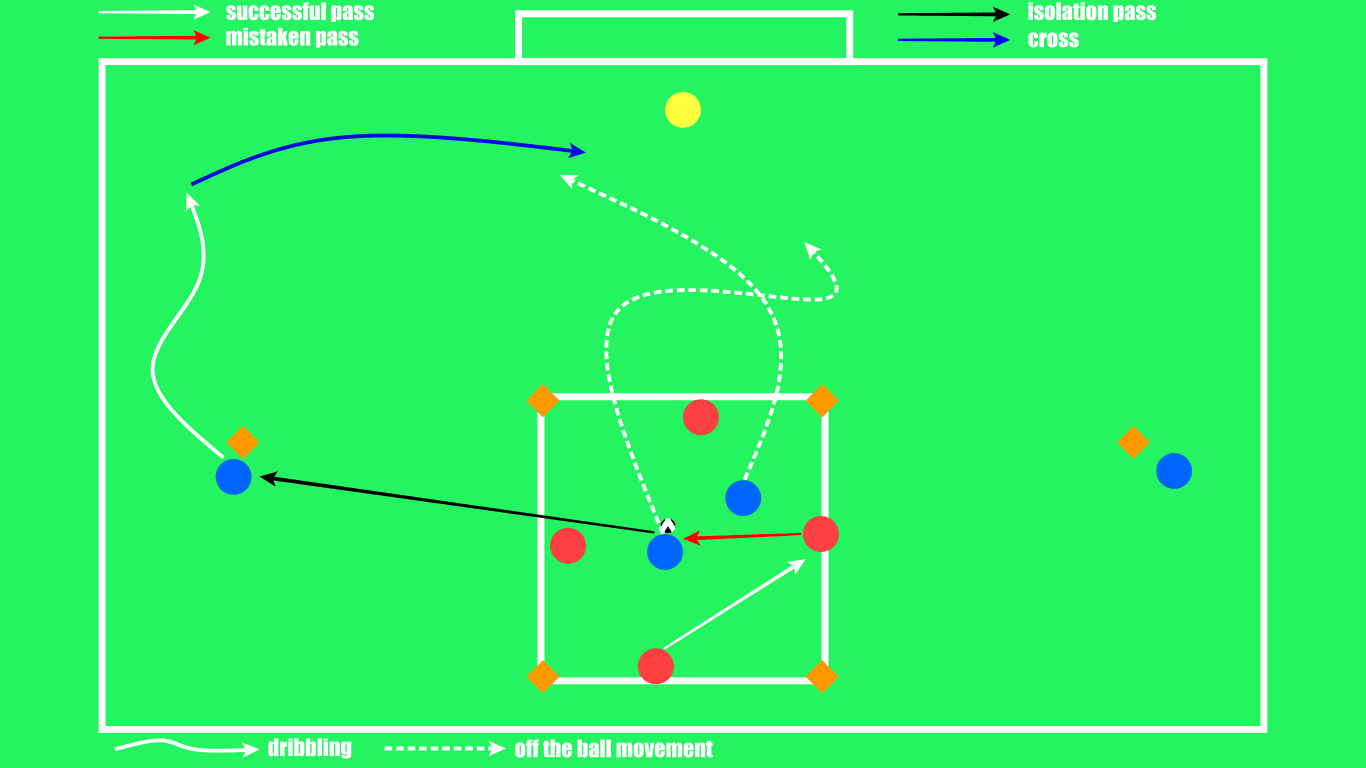
The player who was closer to the wide blue player near the first post then makes the change in movement ending up on the opposite post, while the other player moves quickly towards the closer post in full steam. If the blues don’t manage to break out of the box in 2v4 situation, the reds keep possession and continue working to fulfil their task.
Whenever the defenders win the ball and finish their action, the roles of teams switch, so the reds will have two players on the cones, and the blues will be the attackers. Next, the blue team change into defenders’ roles, the other two players are to go in the wide positions, constantly switching throughout the exercise so every player could spend the same time in every scenario.
The fact that defenders inside the box tend to pass the ball towards the open players on the flanks creates ‘forced’ isolation with no defenders that could prepare your players for some more complex drills on the same topic. This drill is also quite complex in terms of coaching points, as you can work on many segments of the game through it.
It is great for setting your team up to prepare for even more complex and competitive games and unites a lot of factors that are included in real matches. It can be useful for initial isolation training, but also for transition and possession development as well.
Possession + isolation game
The next exercise is a bit more complex as it is a mixture of two sessions wrapped up in one in order to create isolation as its main goal. It is played on one half of the pitch, but in restricted areas – on the left-hand side there is 20-25×15 meter box with two teams of six players, and on the right-hand side there is a narrower field-sized 12×18-20 meter with a goalkeeper and a goal at the far end.
In the smaller area, there are two players from each side, one of each position in the restricted zone at the top of it (first 3-5 meters of length), while two other players are set in the bigger zone. Two fields are separated by 25-30 meters which is important due to factors that will be explained later in the analysis.
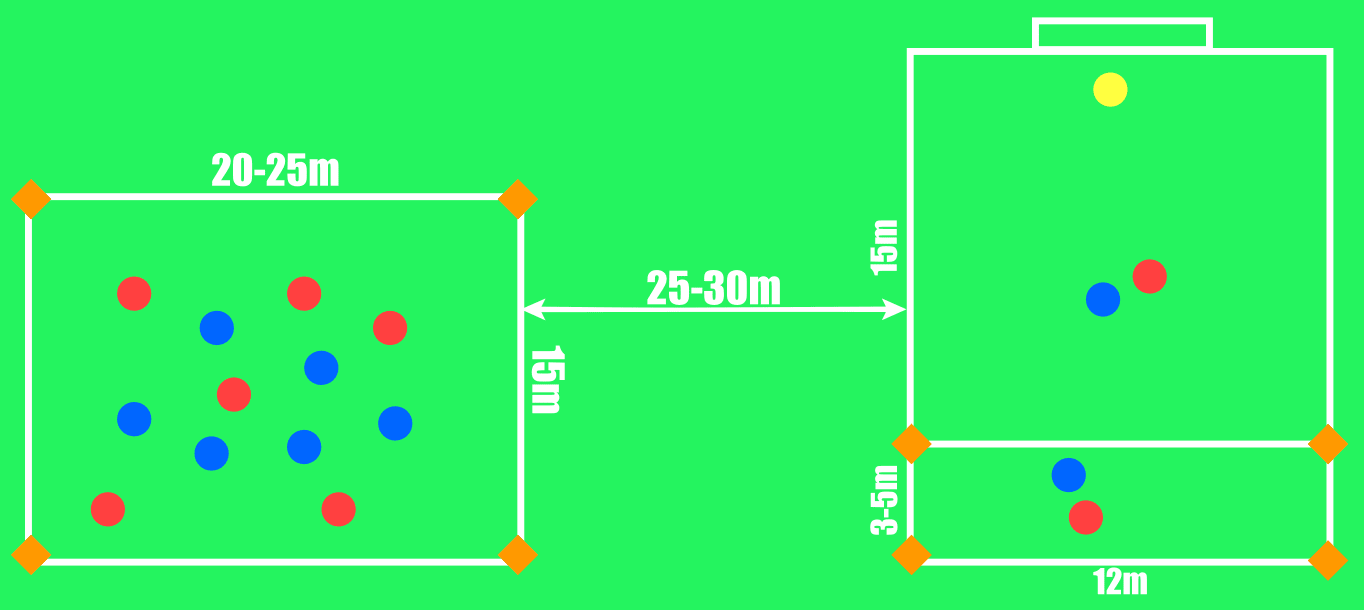
The game starts in the box with more players in it, where two sides play the 6v6 game with a restricted number of touches – in order to make your team play more direct you should encourage them to go with two or three-touch football. The team in possession needs to get up to five passes in order to get a chance to switch the play into the other field.
Teams can’t try to reach out for their players in the second area until they link the given amount of passes, which can vary and can be bigger but in terms of encouraging faster switch of play, it is recommended to go with five.
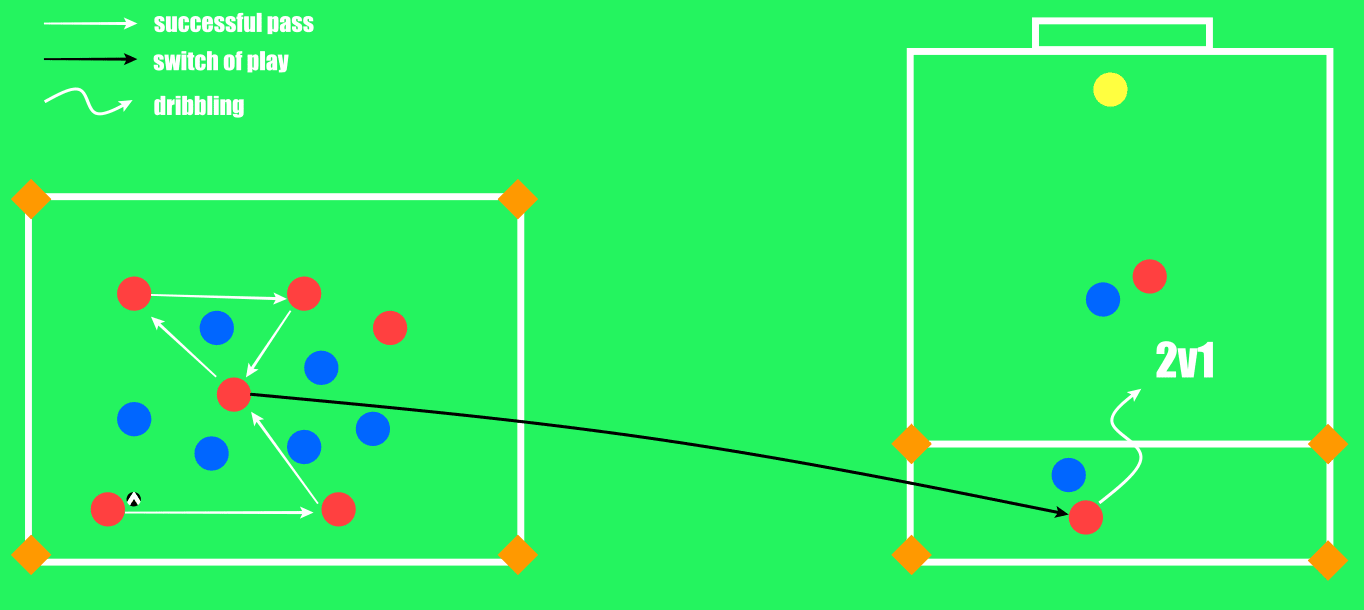
After the team in possession (red team) has completed the task inside their box, they can try and find the player which is positioned in the smaller area of the two on the other side. There is no defence in the small area and the player who received the ball enters the bigger zone in order to create 2v1 situation with his teammate against the defender.
The two players stationed in the right-hand box should be the partners in some line of the team, most preferably strikers, or generally attackers, since they also have the training of individual possession, dribbling, and finally finishing. After the action is finished on the right-sided field, the ball goes back to the box and starts over. If the red team have scored, they once again have the ball first. After finishing, the two players who attacked the goal switch their roles, so both of them can be equally engaged with receiving.
The first coaching point you need to focus on is the factor of security on the ball when the team is in possession in the 6v6 box. You need to encourage them to move constantly, making triangles and providing each other with options, while at the same time ask the defenders to communicate and be well-organised. It is good to potentiate the pressure from the defenders so the team with the ball could think quicker and become more comfortable in difficult situations.
The second factor surely is the counter-pressing, where you need to induce both teams to press aggressively after they’ve lost the ball in order to regain possession as short as possible. The directness of play is secured with the number of passes you ask them to play before the transitive pass towards the opposite side, and their preciseness is developed by the existence of restricted area in the narrower box.
This game that takes place in the left-sided rectangle is a projected setup of overload in order to isolate on the further flank. Your team will get prepared for fast passing in the limited area with the idea in mind to switch the action towards the teammates in a better position, with wider space in front of them. The mixture of communication, transition and real-time exploiting of isolation is the main objective of this drill, so it is quite helpful for coaches who want to orient their tactics that way.
Four-zone overload/isolation + transition
The third drill in this analysis is the most complex one and it is good to be coached in the main part of the practice. First of all, it is set in the 40×25 meter pitch, with goals on both ends along with goalkeepers, so it is basically an “in-game exercise”, but with a lot of tasks. Starting from the half-way line, you have two boxes on the left-hand side, with the restricted areas on the flanks, and the same setting on the right-hand side. The zones that somehow look like a tennis field are filled with players – two teams are made of six, with one player from both teams in each of the central squares, along with the joker, and two players in the wider zones (like in the picture below).
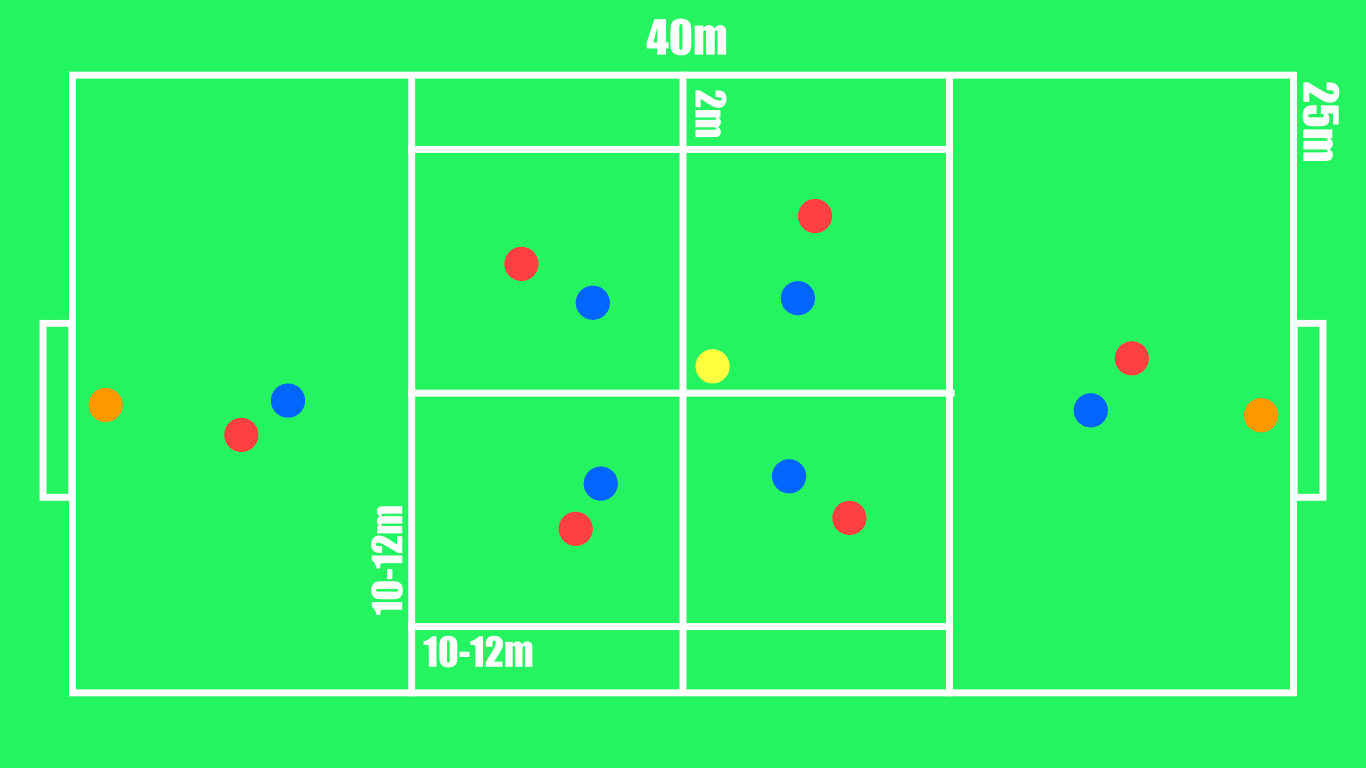
Here you can see the initial organisation of the game before it starts. In the central squares, you have 1v1 setups, and the joker is the player that plays the team in possession with the freedom to move through all the four central areas. The game starts with the team in possession team (red team) having the ball in the first-line of central boxes (the two closer to the left-sided goal, basically defensive midfield roles). The team in possession has a restricted amount of touches and are recommended to limit it to three touches.
When any of the teams are in possession, the play transfers from just one side for example on the left-hand side in order to create an overload, the player from the right first-line box reaches towards the left line on his side and performs his movements on it (this can be changeable, you can allow him to enter the other first-line player’s zone, and it is recommended to do so as the game flows). The joker is free to move in the two zones, and other two players are asked only to move in their areas.
The attacker positioned in the diagonal field to the one that has the ball initially is the only one that is not included in the possession as he runs to the flank and finds himself in the restricted two meters next to the sideline. The task for the red team is to link up to five passes and then to find the isolated player on the opposite side, while blue team are the ones who try to disrupt their play and not allow the play-switching pass.
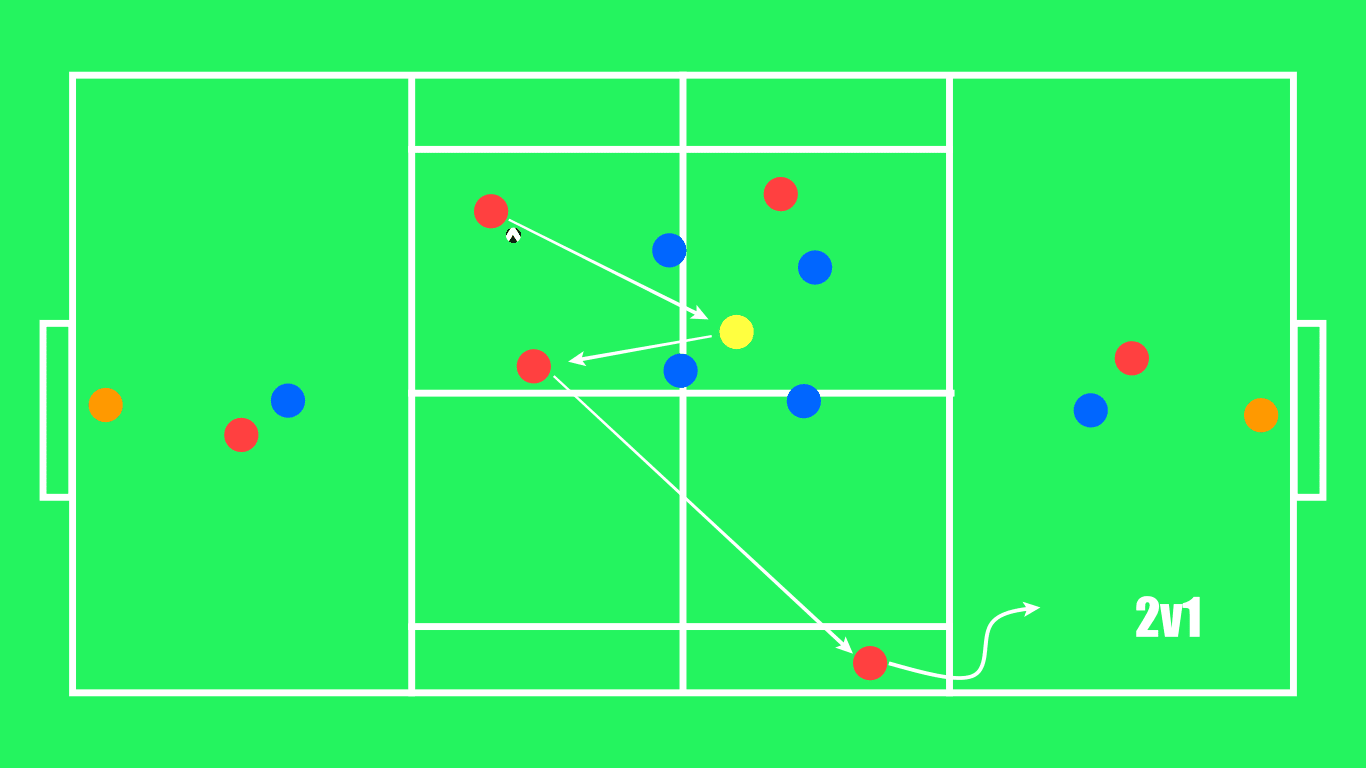
The left-high blue marker is doing the same motion as his opponent from that box and enters the overload box in order to participate in the defensive phase. He and his teammate that were initially in that box move inside. The lower player on that side is limited to motioning in his area, and the defender from the diagonal zone is free to move in both zones of their first-line (zones closer to their goal), so he can be able to try to intercept potential balls towards the isolated player.
Firstly, the task of the blue player is to disrupt the possession inside the overloaded boxes and not to even allow the diagonal pass (you could ask teams not to play long balls after a while, in order to make the drill more difficult). They need to communicate when defending and organise their structure so they can move together and close down the passing lanes that will help the red team count to five passes.
When the wide the red players takes the ball in the isolated position, they enter the bigger field and plays 2v1 with his striker against the single defender. In order to make the exercise more complicated, you can add another option for the possessional team after they play five passes between each other, which would be the direct pass towards the striker who would then play 1v1 against the guard. You can value goals scored from the two setups differently – giving two points for goal after isolation so they’d be encouraged to think that way, and one of the attackers have penetrated directly towards the striker.
The other coaching focus this game has is the transition game. If the reds don’t manage to play five passes, and they made the mistake, the roles switch, and blues have the exact same task as the reds did. That goes for when the fast counter is impossible. A fast counter can take place whenever defenders win the ball in the second line of their action (defensive midfield/first line of opponents’ action). If they get the possession in these zones, they can pass it quickly towards their striker in the left-hand box with the player who passed the ball (or the closest teammate, it’s up to you) joining him in order to create 2v1 situation out of transition.
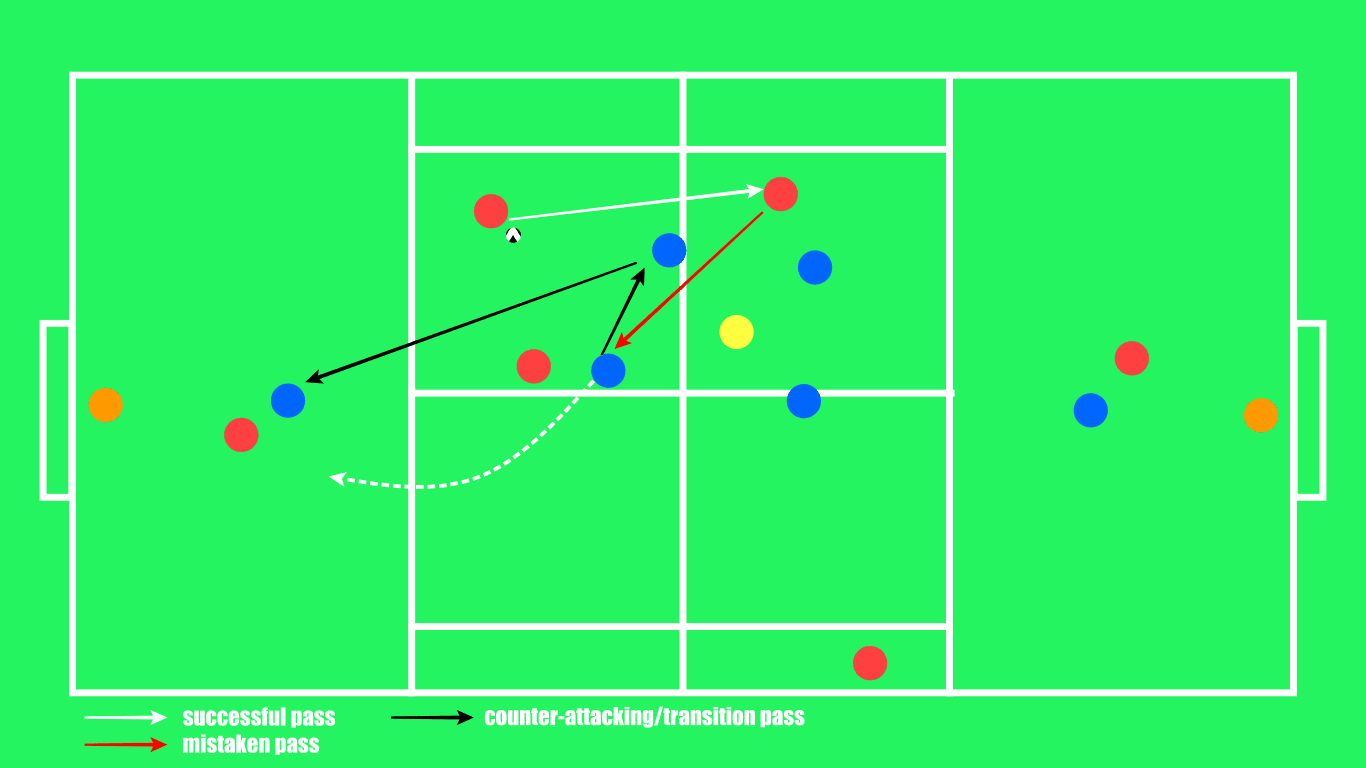
When the transition is disabled, the teams go to the initial setup but with the change in possession, trying once again to overload on the one-hand side and isolate on the opposite. The player who was isolated on the flank comes back to play defence in the overloaded boxes, and the diagonal attacker runs to the sidelined area so he could wait for the isolation pass.
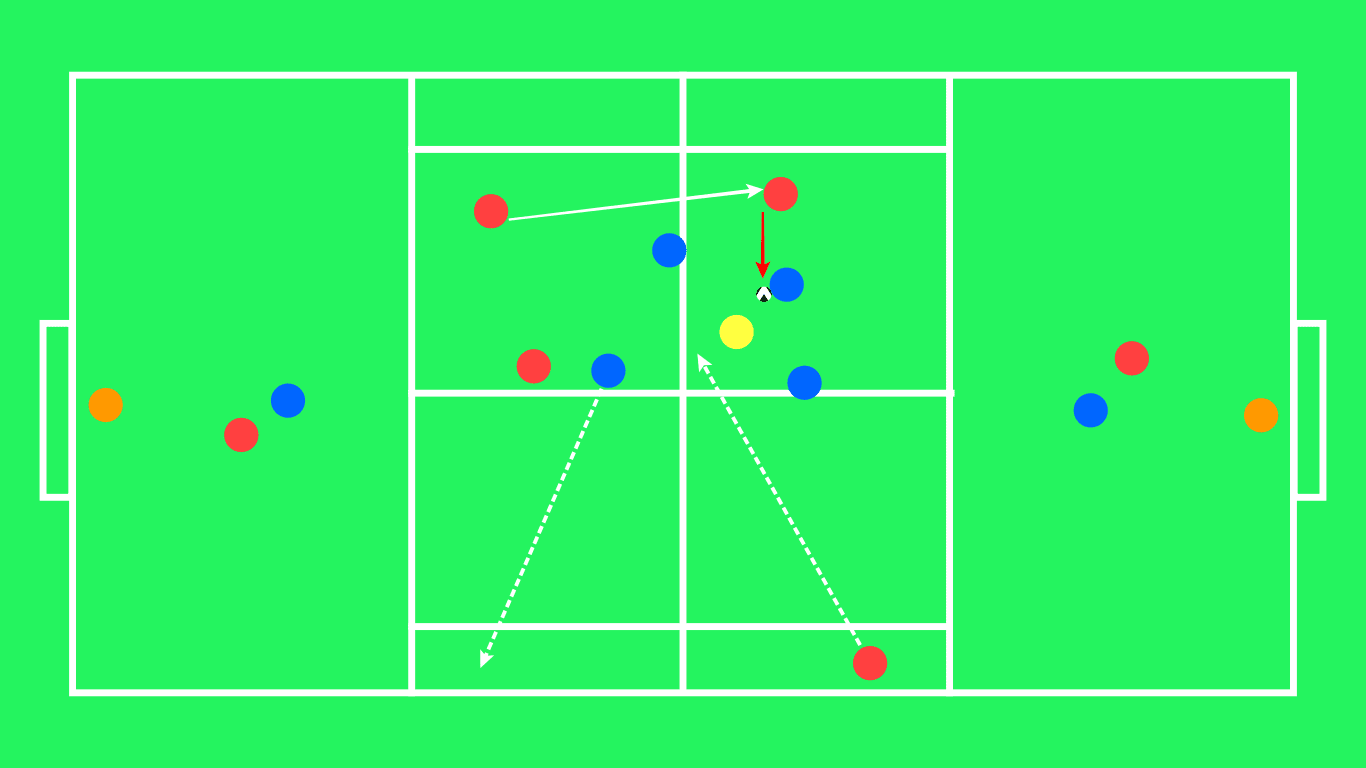
When the ball is lost in the second line of the attack (defensive midfield/first line of the blue team), the blues can’t go with a transition play but are forced to play possessional overload. The strikers in the wide areas are free to move however they feel is fit, as they potentially provide teammates with a penetrating option that could be awarded one point if they score.
It is recommended to place your players in the zones in this manner: two players in the first-line zones – defensive/central midfielders, two players in the second-line zones – attacking midfielders/wingers, players in the bigger zones – striker-defender duos.
This game is a great mix of plenty of coaching points and it is a brilliant tool for making your team think about isolation, but also it teaches them to move inside the right areas and to get comfortable in the small spaces. As it also engages defensive communication, organisation of defensive structure, it is an excellent drill for the high-intense stages of training and can be of direct influence on what you will see from your team in the matches.
Conclusion
“Overload to isolate” is one of the most valuable ideas in modern football if it is done the right way. Playing the overload game requires patience and good organisation of actions, along with security on the ball and good decision making in the limited space and time gaps.
The idea of this concept is to dominate the possession as long as you can and to dominate situations by controlling the setups on the field, creating advantages in the spaces that are most vulnerable and where your team has the best chance to penetrate and endanger the opposition defence.
This coaching tactical analysis has pointed some of the best drills out there for enabling your side focus on the isolation as the potential main factor of their offensive tactics. Since that isn’t the only thing on which these exercises focus, it will surely help you develop your team in plenty of other segments of the game, and most importantly they could directly influence your gameplan.





Comments